Disclosure: Meeple Mountain received a free copy of this product in exchange for an honest, unbiased review. This review is not intended to be an endorsement.
For my “day job”, I support my company’s corporate responsibility team: diversity, volunteerism, and environmental sustainability. All three of these pursuits are personal passions, but it’s hard to find games that align with those core values.
The game Earth, published by Inside Up Games and coming to Kickstarter soon, features many familiar game mechanics in a world where the words “soil”, “plants”, “ecosystems” and “composting” are the language of gameplay. It’s an interesting puzzle, and I’ll admit it’s hard to find games that align with a mission that speaks to the importance of our environment. I just wish the game was as fun as its lofty aspirations.
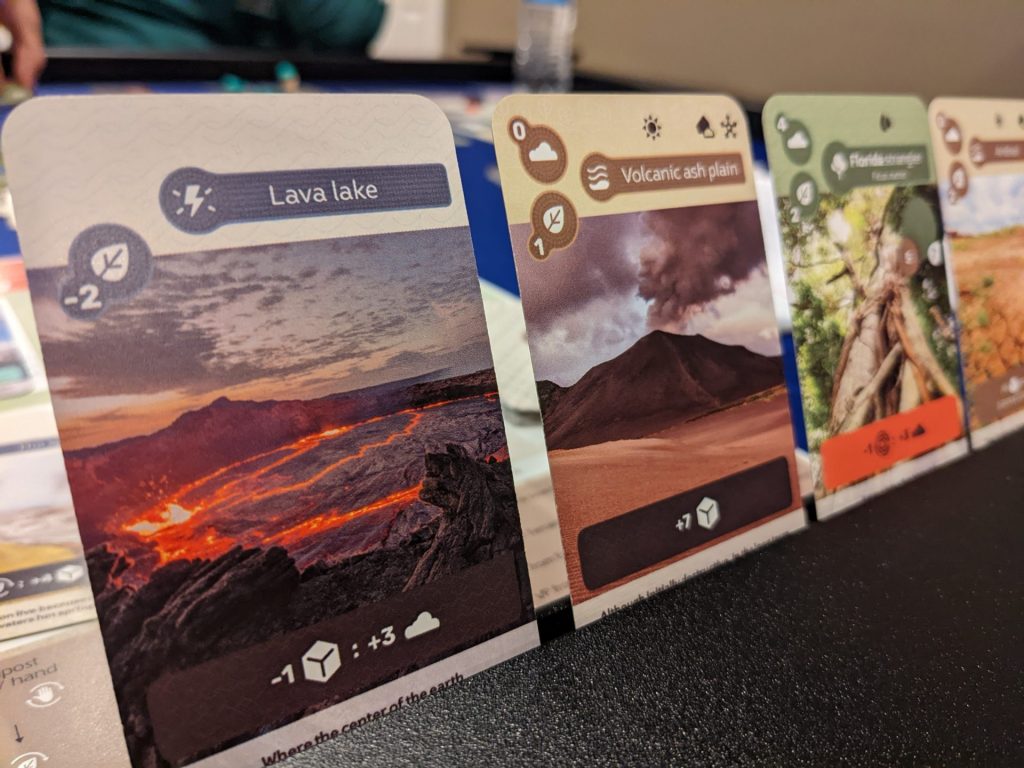
4×4
Earth is a tableau builder, where players have to “plant” cards into a 4×4 tableau in order to trigger the end of the game.
There are cards EVERYWHERE in Earth. 364 cards, all unique, some double-sided, most which can be played into the tableau with abilities that trigger throughout the game, even on other players’ turns.
Earth fully commits to the ecosystem theme here, right down to the names of the four actions available to players on a turn:
- Planting allows players to put 2 cards into their tableau by paying each card’s cost in soil tokens, then drawing 4 cards, choosing one to keep.
- Composting provides soil and the chance to add cards to the compost stack on your player board; many secondary actions can be paid for with cards from your compost pile.
- Watering grants players both soil and plant cubes, the latter of which can be added to the plant cards in your tableau with space for cubes. These cubes are often used to trade for other resources, and they are worth a point each at the end of the game.
- Growing lets players draw 4 cards and add 2 Growth Pieces to cards which have space for trees.
All of these actions have secondary actions available to all of the non-active players. So, if it’s your turn, and you take the Planting action, I can still plant a single tree and draw a single card. If you take the Composting action, I can either take 2 soil or add 2 cards from the draw pile to my compost stack.
After all players have completed an action, all players have to do one more thing: activate all of the cards in their tableau with an ability matching the color of the chosen action.
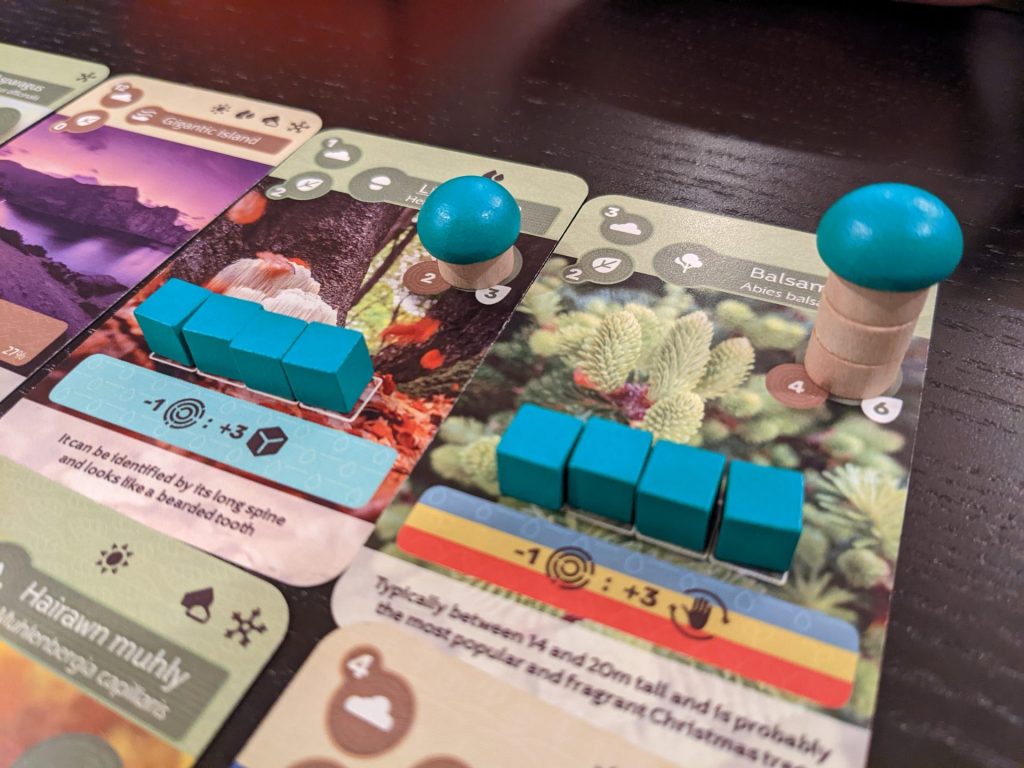
Zero Downtime
It’s this last part that will either make or break your experience with the game Earth.
Because everyone can do at least a little something on every turn before activating any cards that match the color of the associated action, Earth is a turn-based game that features zero downtime. When it’s your turn to choose an action, there’s plenty for me to do. When it’s my turn to choose an action, there’s even more to do. And no matter who is taking a turn, you have the chance to potentially activate some, or maybe all, of the cards on your player board and your tableau, one by one, in order, from top to bottom, left to right.
That makes for an incredibly busy, involved experience. Every single turn. (You want a bathroom break? No time. Check your text messages? Maybe after the game is over. Grab some chips and a beer? SIT DOWN!! )
Here’s the part that I noticed during all 3 of my multiplayer plays of Earth: no one was really talking.
Sure, someone says “I’m taking the green action” (no one has said “I’m taking the Planting action” so far). Then, all of the players at the table put their heads down and execute the main or secondary action for that color. Then they take a few moments to math out where they will place a card in the tableau, or begin taking, say, green actions on 3 or 4 cards in their play area.
I was immediately whisked away to my experience playing Paladins of the West Kingdom for the first time, where my group of 4 players didn’t say anything to each other for 45 minutes. Earth has many of those moments; it’s fun to figure out how to best score your tableau by placing cards in just the right places, but it’s not a terribly interactive experience. There are no take-that cards that I’ve seen, so you aren’t about to stop anyone’s engine from really taking flight. Unless someone asks a clarification question, you will be almost completely heads-down doing your own thing.
Not talking while building an engine? Perfect for many of my gaming friends, so you might be right at home with Earth. But I like table talk. I like watching other players as they execute sweet combos to activate a river of points on a single turn. I like a little smack talk here and there. Earth seems bent on curbing that.

The Earth Deck
My favorite part of Earth is the buffet of cards. There are 364 cards in the box. As shocking as that number is, it was more shocking to me that every one of these cards is unique. Different artwork, different flavor text, different point values, different titles, different abilities, and sneakily different traits that play into many of the end-game scoring cards.
The real genius of Earth is how designer Maxime Tardif found a way to make the cards subtly different enough to squeeze so many different ways to change the text on these cards. Cards with underlined titles? Animals. Italics are used for color-themed words used to name some of the Plant cards. Some of the abilities on Terrain cards are bordered by tiny white lines, to indicate a directional challenge. There are four habitats, which also play into many of the Fauna milestone cards. There are 4 card types, which act like suits to give you something else to look for when playing scoring cards.
There are a couple dozen different Island and Climate cards, to provide options for starting resources and ongoing powers. The Ecosystem deck, which like the Island and Climate decks include double-sided cards, provide a couple dozen more options for a variable setup. In the regular format of the game, there are a whopping 7 milestones you will be working towards to score points at the end of the game, from a selection of at least 100 different public and private goals.
Earth is going to play slightly differently every single time. I’m critical of games that don’t provide enough variability, but Earth crushes that critique as soon as you open the box. The rulebook does an excellent job of describing different ways to play it to keep it even fresher: a beginner and experienced Fauna/Ecosystem milestone board, solo play, team play, beginner and advanced rules for other ways to challenge more experienced players.
One final note on the production of Earth: the Growth Pieces. You wanna build cute little trees onto your tableau? Earth has you covered, by using beige tree trunk pieces to serve as the base, with green canopy pieces to stack on top of the trunk pieces. You’ll have trees of varying heights everywhere, and combined with the card artwork you will always finish a game of Earth with a handsome product on the table.
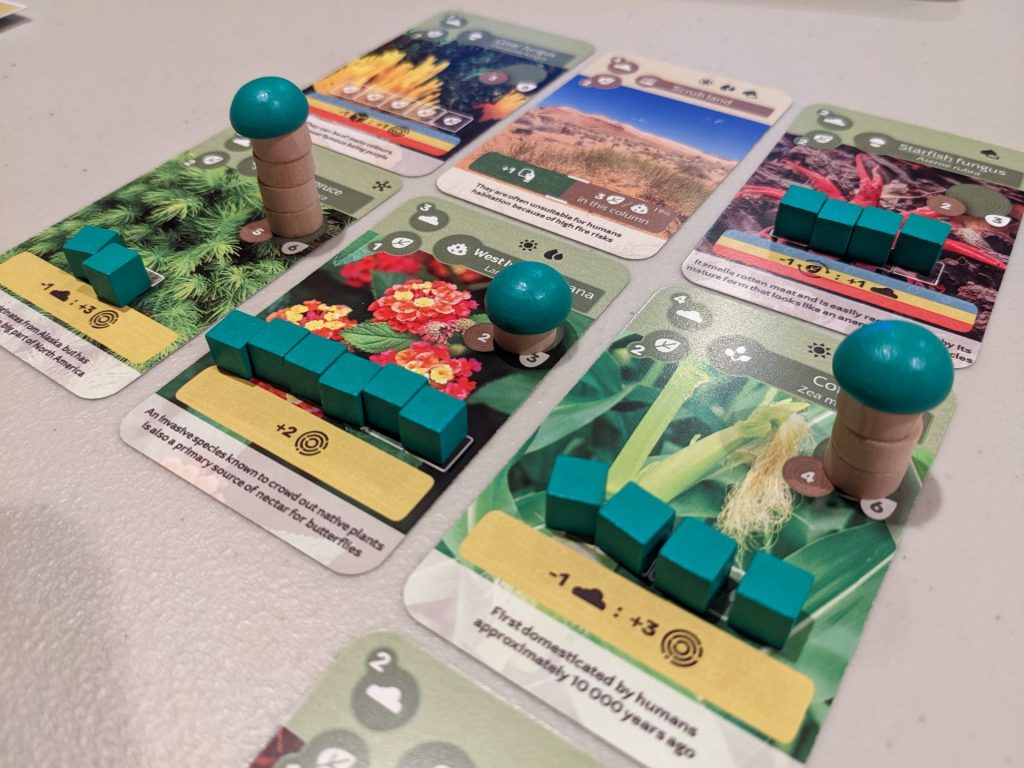
A Kinder, Gentler Tableau Builder (for Gamers)
Earth is a friendly way to get into the business of building an engine, as long as you are experienced in the hobby.
I say that knowing how tedious turns can be, moving through your cards to run each turn’s accounting: grab a couple of soil resources, then begin to do little things on a half-dozen cards. Compost a card from your hand to take 2 plant cubes, then place one Growth Piece, then play an Event card to discard 2 cards from your compost pile to take 3 more plant cubes, then spend a soil to draw 2 cards. And if you are playing this at the max player count of 5 players, and a couple of the other players also take the same action, you are doing that sequence again. And again. And again.
However, solving the Earth puzzle can be satisfying because every single thing in the game scores points. Growth Pieces score you points, even on unfinished trees. You’ll likely achieve one or two public goals even if you weren’t really trying. All of your planted cards score. All of your plant cubes score. You’ll get a 7-point bonus if you complete your 4×4 grid first. Some of your Terrain cards score you points, and some of those point bonuses are appropriately wild (2 points for every card with a “Wet” habitat icon in a diagonal row as long as the base point value is even). As involved as some of your turns will be, scoring at the end of the game is a zoo.
Tiebreakers? A whopping FIVE of them, and that’s in the incredibly unlikely case that with 8 main scoring categories you somehow end the game dead-even with another player. I’ve seen scores in my 4 games range from 129 to 235. Wild!
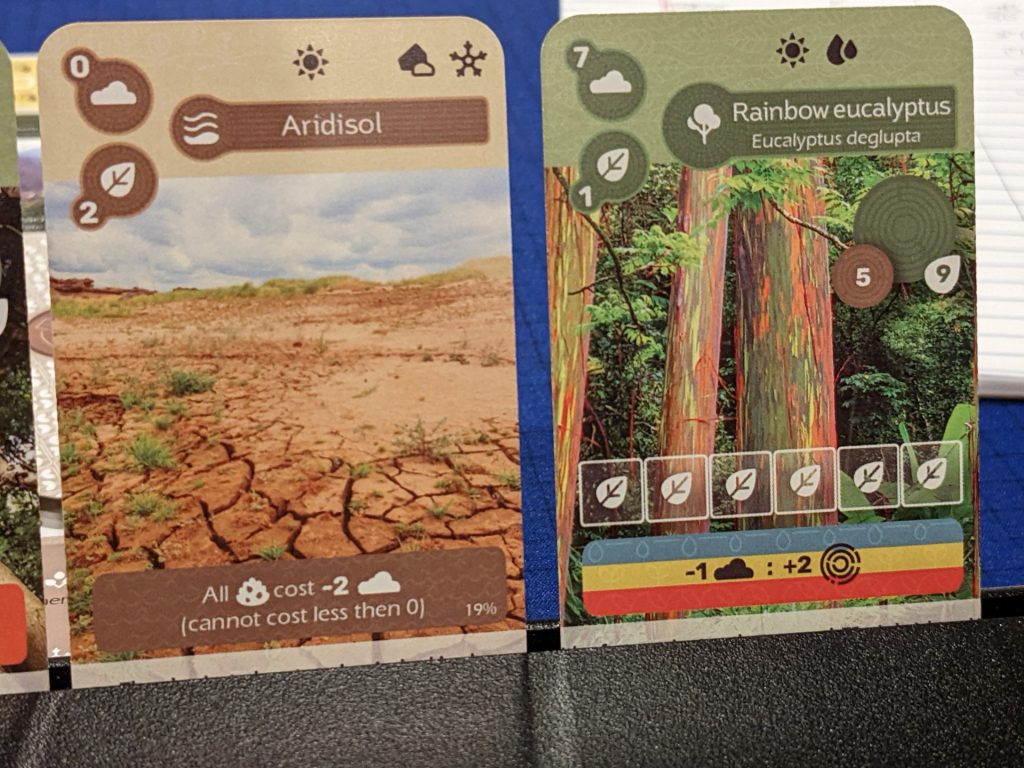
I wish Earth was more interactive. And I can already see myself enjoying Earth as an app or on Board Game Arena, so that some of these processes become automated and I don’t miss anything as I move from card to card, activating all of the cards in the proper order. But then again, I’m sure the final product will look great on a table, if the quality of my prototype is any indication.
Earth is a qualified recommendation. It’s a busy and involved engine builder that features simultaneous play and crunchy decisions, but the game will really need multiple plays to get to the heart of how to best maximize efficiency, particularly on other players’ turns. The variability is peerless; every game will offer something a little different, from public goals to player board powers tied to the Island and Climate cards.
The game doesn’t overstay its welcome thanks to simultaneous play; I haven’t had a single game last longer than an hour. The actions are easy to teach; you might spend just as much time doing end-game scoring as you will doing the 10-minute teach. Just don’t teach this game to a person brand new to the hobby; I think a casual gamer may struggle with slowing the game down to make decisions on where to place cards and how to follow through on all of the actions that trigger every turn.
I played Earth 3 times solo, and once each at 2, 3 and 4 players, for a total of 6 plays. All of the players who joined me at the table enjoyed it, but the general sense was that the game was fine, but never thrilling. While I enjoyed certain aspects of Earth, such as the variability, the massive deck of cards, and those cute little trees, Earth is not a game I would push to the table very often thanks to the extreme lack of interaction. The theme draws me in for personal reasons, but as a game, nothing is particularly special when Earth attempts to deliver fun.
Check out the Kickstarter to see more of Inside Up’s vision for Earth!


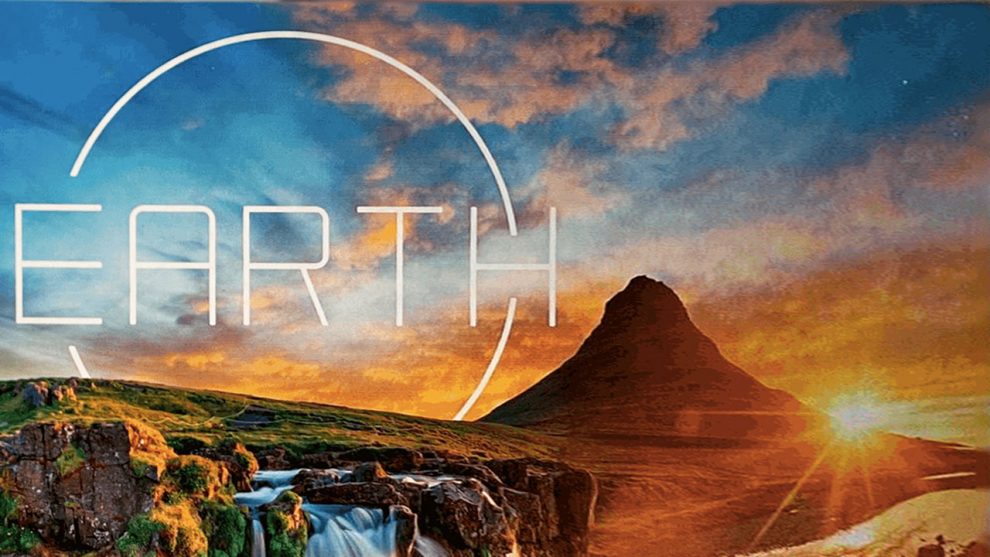


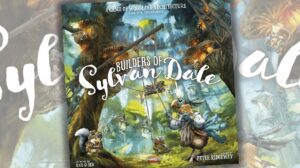






I appreciate the article and your thoughts on it. What did you think of the solo play? And is it a beat your score or play against the AI sort of game.
Thanks for the note Mike! The Earth solo mode is a mix; the game plays faster than a normal game does and I used it as a high score mode to learn some of the strategies for maxing out my scores. There’s a small deck of cards the AI uses to dictate action selection, and the game only lasts for 12 turns. It is very easy to administer but I would not purchase the game only to play it solo. Hope this helps!
I thought the rulebook was horrible to follow- very confusing and left me with more questions. Like what’s the deal with the habitats? I just wish a little more effort went into it. Even when playing solo after with a group the instructions were so unclear. The set up as you normally would without hardly any mention of what fauna mat to use, how many fauna to pick, etc was very frustrating. To top it off, the Gaia vs your turn instructions seemed very jumbled. It just felt like there were a lot of shortcuts made. I hate that some of the pieces are made of cardboard. That just seems cheap for how expensive the game is. The biggest challenge of the game was following the instructions. The rest of it really wasn’t challenging.